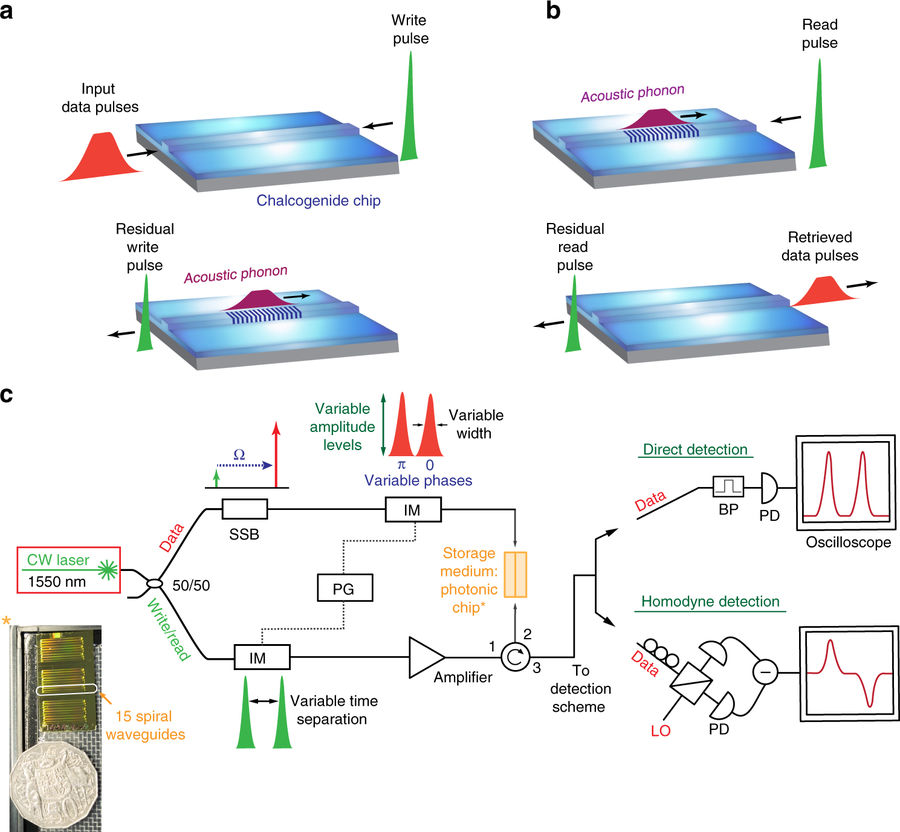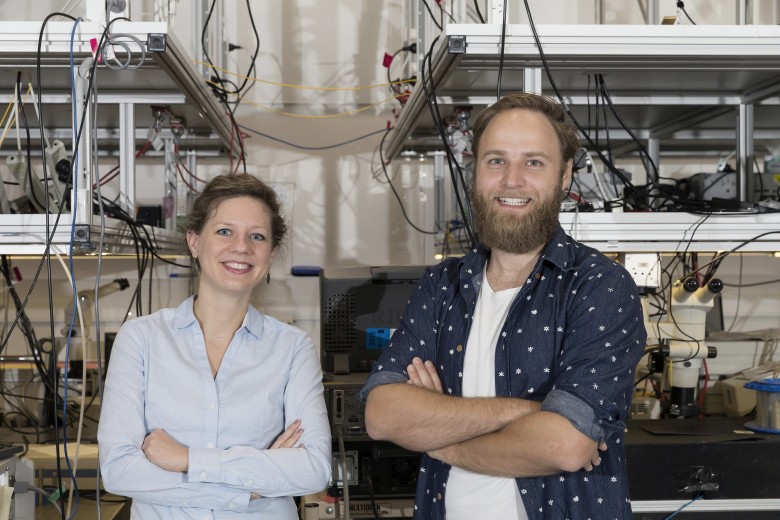Photon-phonon memory temporarily converts light into sound for processing

The basic principle and the installation of photon-phonon memory. but. Storage process: a pulse with optical data is depleted by a strong pulse to write in the opposite direction, saving the information in the form of an acoustic phonon for several nanoseconds. b. The extraction process: the reading pulse depletes the acoustic wave, converting the data back into optical form. c. Simplified experimental setup. The inset shows a chalcogenide chip next to a 50 cent Australian coin. The chip contains more than 100 spiral waveguides of various lengths (8.6; 11.7 and 23.7 cm). The full scheme of the experimental setup was published in a scientific article .
Researchers from the Nanoscience Center of the University of Sydney managed to significantly (by five orders of magnitude) slow down data transmission in an optical chip, transferring information from optical waves to acoustic ones . That is, the information is reliably transmitted inside the microchip as a sound, and then converted back into light. The microcircuit simultaneously operates at different wavelengths.
A stable transformation between optical and acoustic waves inside a microchip is important in the development of photonic integrated circuits, engineers emphasize. Photonic microchips are being developed for use in telecommunications, fiber-optic networks and cloud data centers, as well as in any other areas where electronics may be exposed to electromagnetic radiation or the owner wants to reduce power consumption and heat generation of devices.
“Information in our chip is transmitted in an acoustic form at a speed that is five orders of magnitude slower than in an optical form,” says Dr. Birgit Stiller, a research associate at the University of Sydney and the project manager. “It's like the difference between thunder and lightning,” she leads a figurative comparison.
')

Dr. Birgit Stiller (left) and doctoral student Moritz Merklein from the Nanoscience Center of the University of Sydney
The presence of short-term delay is very important, because at low speed it is possible to delay data in the microchip for storage and processing, even for a while. After that, they are again transformed into a light form - and move on. Light is great for fast data transmission over long distances, but when processing information, photons are not the best medium, scientists explain. “Creating a sound buffer inside the chip improves our information management capabilities by several orders of magnitude,” said Moritz Merklein, a doctoral student at the University of Syntney Nanoscience Center.
Currently, the slowdown of information and its processing occur in an electrical form, but because of this, there are problems with overheating and power consumption of devices. New photon-phonon memory, not using traditional electronics, offers a solution to this problem.
The microcircuit in the photo above is made at the Center for Laser Physics of the Australian National University. Unlike previous developments, it is not limited to a narrow band, but simultaneously operates at different wavelengths. Spiral waveguides in a microcircuit are made of soft glass, called chalcogenide. In it, the speed of sound is much less than in silicon, so it can be said that these few nanoseconds information is stored in a waveguide in a sound form.
Photonic chips have many advantages over conventional electronics, based on the transfer of electrons. First, the bandwidth increases. Secondly, there is no heat dissipation associated with electrical resistance. Unlike electrons, photons are resistant to electromagnetic radiation. Therefore, already now optical integrated circuits are widely used in optical networks and communication systems, as well as in equipment resistant to the effects of an electromagnetic pulse.
Further work of scientists will be aimed at extending the lifetime of the sound waves inside the waveguide. Although the current time in a few nanoseconds is enough, for example, to synchronize data from several processors, allowing you to get rid of the use of electronics and related problems (especially excessive heat generation).
The scientific article was published on September 18, 2017 in the journal Nature Communications (doi: 10.1038 / s41467-017-00717-y).
Source: https://habr.com/ru/post/373839/
All Articles